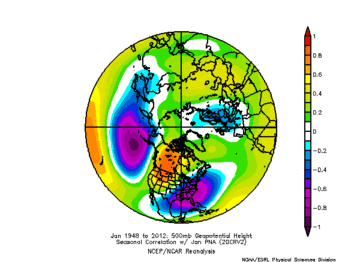20CR Climate Indices: PNA
- Description:
- (from CPC) The Pacific/ North American teleconnection pattern (PNA) is one of the most prominent modes of low-frequency variability in the Northern Hemisphere extratropics. The positive phase of the PNA pattern features above-average heights in the vicinity of Hawaii and over the intermountain region of North America, and below-average heights located south of the Aleutian Islands and over the southeastern United States. The PNA pattern is associated with strong fluctuations in the strength and location of the East Asian jet stream. The positive phase is associated with an enhanced East Asian jet stream and with an eastward shift in the jet exit region toward the western United States. The negative phase is associated with a westward retraction of that jet stream toward eastern Asia, blocking activity over the high latitudes of the North pacific, and a strong split-flow configuration over the central North Pacific.
- Image:
- Calculation Method:
-
We use CPC's method here http://www.cpc.noaa.gov/products/precip/CWlink/pna/month_pna_index2.shtml. Using the 20CRV2 dataset an area average is created of four regions and these regions are combined.
PNA = Z*(15°N-25°N,180-140°W)-Z*(40°N-50°N,180-140°W) +Z*(45°N-60°N,125°W-105°W)-Z*(25°N-35°N,90°W-70°W)
Then, the 1950-2000 monthly climatology is removed for each grid/time from the 500mb heights and the values standardized. There are other methods to calculate the PNA. For example, this version of the PNA from NOAA/CPC uses rotated EOFS of the 500mb heights anomalies. Point averages have been used as well. - Time Interval: Monthly
- Time Coverage: 1871 to 2012 (20CRV2)
- Time Coverage: 1851 to 2014 (20CRV2c)
- Update Status: none
- Get Data:
- Time Coverage: 1851 to 2014 (20CRV2c)
-
20CRV2c PNA index: Standard PSL Format (What is standard format?)
20CRV2c PNA index: Standard PSL Format (1948 onwards version)(What is standard format?)
20CRV2 PNA index: Standard PSL Format (What is standard format?)
20CRV2 PNA index: Standard PSL Format (1948 onwards version)(What is standard format?)
- Webtools:
- Source:
- NOAA/ESRL PSL using method detailed above.
- References:
-
- Barnston, A. G., and R. E. Livezey, 1987: Classification, seasonality and persistence of low-frequency atmospheric circulation patterns. Mon. Wea. Rev., 115, 1083-1126.
- Chen, W. Y., and H. van den Dool, 2003: Sensitivity of Teleconnection Patterns to the Sign of Their Primary Action Center, Mon. Wea. Rev., 131, 2885-2899..
- van den Dool, H. M., S. Saha, and Å. Johansson, 2000: Empirical Orthogonal Teleconnections. J. Climate, 13, 1421-1435.
- The Twentieth Century Reanalysis Project used resources of the National Energy Research Scientific Computing Center managed by Lawrence Berkeley National Laboratory and of the Oak Ridge Leadership Computing Facility at Oak Ridge National Laboratory, which are supported by the Office of Science of the U.S. Department of Energy under Contract No. DE-AC02-05CH11231 and Contract No. DE-AC05-00OR22725, respectively. Papers using the Twentieth Century Reanalysis Project dataset are requested to include the following text in their acknowledgments: "Support for the Twentieth Century Reanalysis Project dataset is provided by the U.S. Department of Energy, Office of Science Innovative and Novel Computational Impact on Theory and Experiment (DOE INCITE) program, and Office of Biological and Environmental Research (BER), and by the National Oceanic and Atmospheric Administration Climate Program Office."
- Other Links
 | Spatial pattern of the 20CRV2 PNA timeseries. Correlation map uses January 1948-2012 monthly 500 heights from the NCEP/NCAR R1 dataset. |